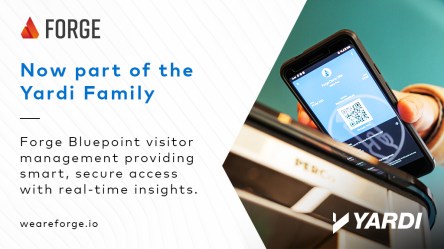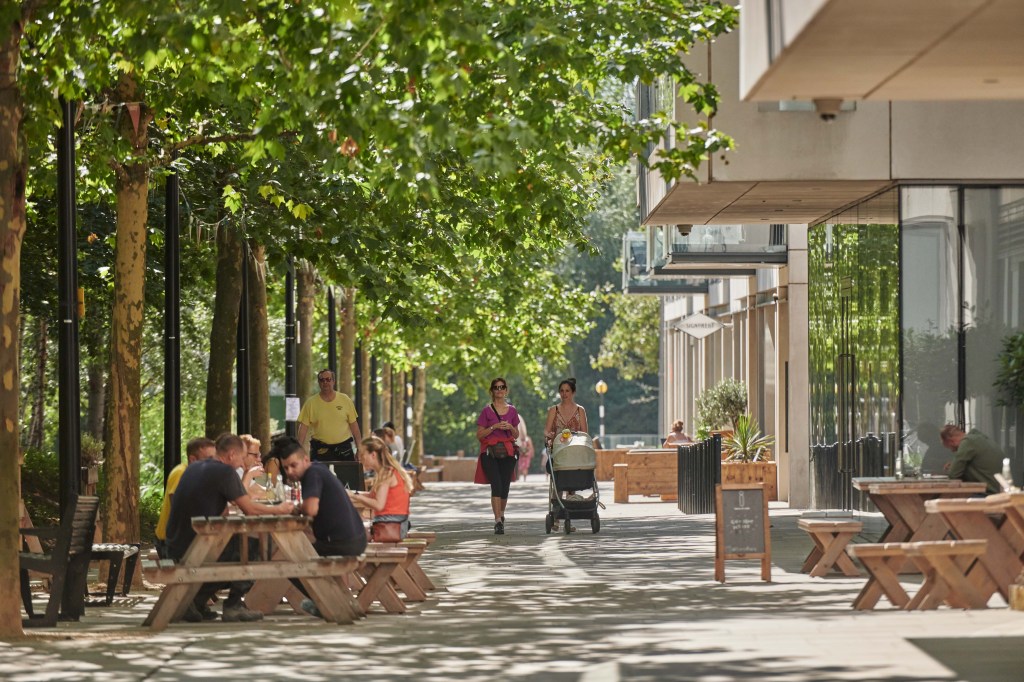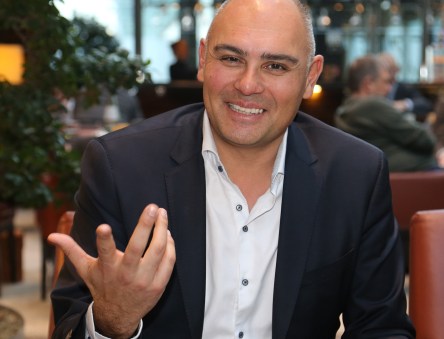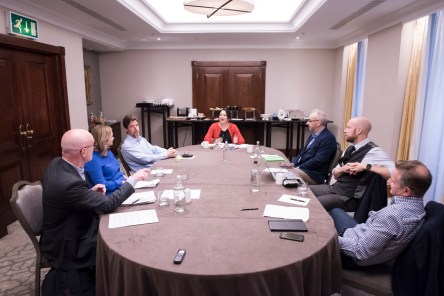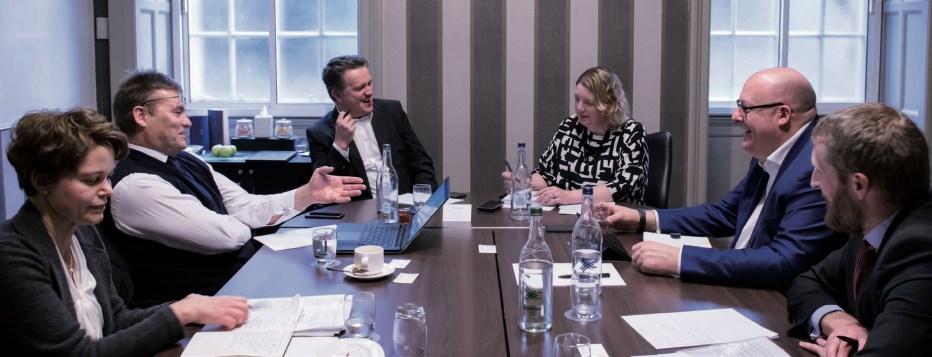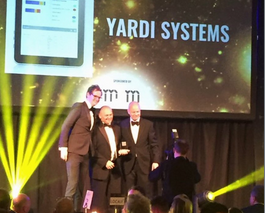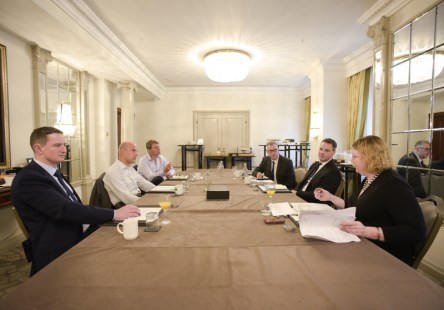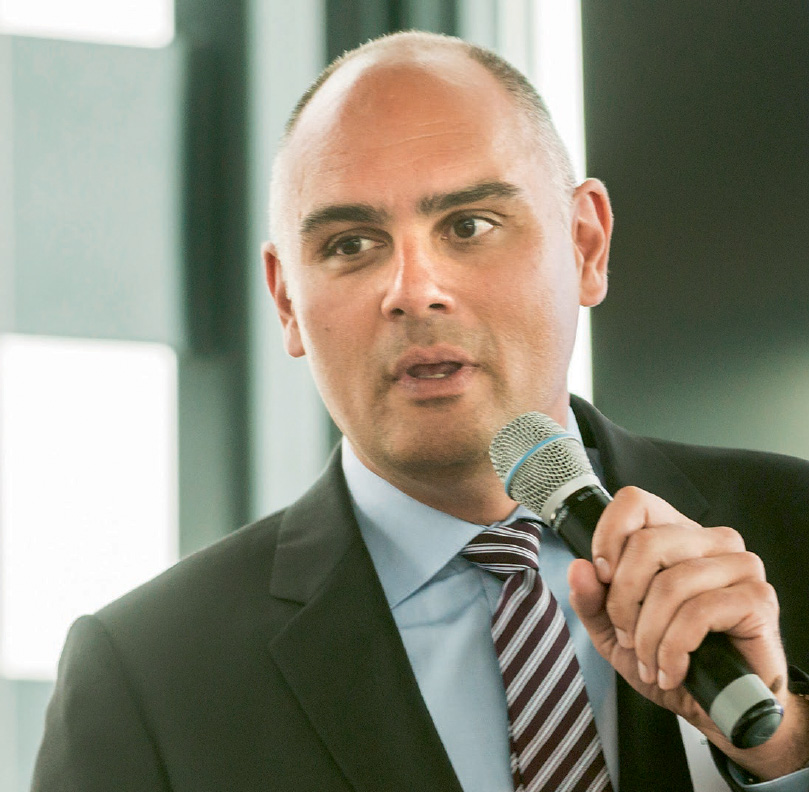Get Living creates exceptional communities and neighbourhoods across the United Kingdom. Places where people can live their best lives, homes they feel they belong in, and communities they can connect in with people. The team at Get Living understand the important role technology plays in connecting residents to their communities and that delivering exceptional resident experience goes hand in hand with adopting efficient technology. We caught up with Chris Armstrong, Chief Experience Officer and Steven Osei Head of Brand Experience of Get Living to ask them how they use Yardi’s technology to improve resident experiences and business processes. “We’ve been working with the team at Yardi since 2016/2017, using a wide variety of the solutions they provide, across the entirety of our estate. We invested heavily into Yardi’s solutions to help us grow as a business and to really deliver consistency of experience,” commented Chris Armstrong. Osei expressed that since utilising Yardi’s technology, the team at Get Living have been able to reduce the steps in the applicant journey by 300%. He also explained the importance of adopting technology to achieve Get Living’s growth goals, “As a growing and scaling business with the aspirations of having 12 to 15,000 homes it’s imperative that we have the tools in place that enable us to display real time availability of homes that we have available”. Armstrong also commented that over 4,500 of their residents are registered on the RentCafe Resident App which has given their residents the platform to interact with them on a 24/7 basis, “It’s always there for them, it’s always on.” Armstrong explained that they monitor resident satisfaction by surveying residents using the resident app; freeing up their teams to focus on hands-on customer service. “The best technology is the technology that you don’t know is there, it fades into the background. That’s why we work really hard with Yardi as a partner to make that technology seamless and easy for our teams and our customers to use.” As well as explaining how Yardi’s technology currently benefits their staff and residents, Armstrong also detailed future adoption plans which will see improvements in procurement process and allow for more flexible leasing with Yardi’s technology. Watch the...
Yardi Acquires Forge
Tech access solutions
Yardi has announced the acquisition of We Are Forge Ltd (Forge), a Bristol, UK based software company that specializes in visitor management and smart access control for real estate assets including, office, retail, industrial, flexible workspace and the education sector. Founded in 2013, Forge is based in Bristol, UK. Forge designs and develops software that connects people and buildings. Forge Bluepoint Visitor Management, is currently used across 22 million sq ft of property in the UK by high profile companies including Landsec, HB Reavis, John Lewis and Partners, CBRE and Savills. The company’s Forge Bluepoint product is a cloud-based visitor management solution that connects to access control for many of London’s premier office buildings and allows companies to manage visitors flexibly and securely. From arrival and contactless smart access, Forge Bluepoint also integrates with other building technology such as meeting room access, lifts and car parking. “We are delighted to become part of the Yardi family. Working together, we will ensure Forge Bluepoint is the leading visitor management solution across the sectors we work in,” said Paul Speariett, co-founder and director of Forge. “This is an exciting phase for Forge and our team and we are greatly looking forward to the future and being part of Yardi’s end-to-end technology offering.” “We are excited to welcome the whole team at Forge to the Yardi family,” said Neal Gemassmer, vice president of international for Yardi. “This further demonstrates our commitment to invest in innovative teams and technology to better serve the industry.” To learn more, please visit:...
A Lifestyle Experience
Meet Chris Armstrong of Get Living
Meet Chris Armstrong, director of brand, product and technology at Get Living, an innovative build-to-rent operater in the UK that prides itself on delivering unforgettable resident experiences. We recently had the chance to sit down with Armstrong and learn more about how the company is challenging and changing the renting experience. “We are all about innovating the resident experience at Get Living. We were the first to scrap deposits back in 2017 and we’ve never charged fees. It’s something that our residents value – it not only builds trust but affirms our role as an innovator within the sector,” said Armstrong. “Our focus is purely on the customer experience; from first enquiry to move in, right through the tenancy and when resident’s leave us. We continue to challenge ourselves to meet our residents growing expectations of us to deliver a simpler, better and more rewarding renting experience,” he explained. Read on to learn more about Armstrong’s perspective on resident experiences and how they will transform the marketplace. Q: So it’s all about the experience – How does Get Living deliver it? Armstrong: Residents are attracted to our quality homes and our quality service. Since launching in 2013 we’ve continued to challenge the norms of renting and evolve our offer finding more ways to take the hassle out of renting. Yardi RentCafe has helped us achieve that with both new customers and existing residents. The property websites and the online functionality from Yardi enables us to deliver a great online presence. We can display available units as well as showcase each neighbourhood’s amenities all within the Get Living brand platform. Prospects can complete the entire application process online, enabling us to onboard residents quickly and easily. Our leasing cycle has greatly reduced since introducing Yardi – where renewals would have taken 3-5 days, our relationship managers can turn these around in under an hour. For our marketing team, the increase of web traffic is a major goal, as is nudge marketing and social engagement. It means we are fully maximising marketing ROI, and seamlessly bringing the resident a great experience. Q: It looks like Yardi technology impacts not just your business operations, but the residents life too – how important is technology to their journey with you? Armstrong: Email is dying, our residents rarely use it – in fact we rarely use it on the operational side now either – we are moving to an app-based business. With Yardi’s new white label resident app MyCafé by RentCafe, we are able to completely brand the renter experience in the Get Living style. We encourage our residents to use the resident app, and we provide a user guide and training for each new resident to further communicate its value and benefits. The app is a far more effective way of communicating with our resident demographic. It also delivers far greater efficiency and mobility for our team, allowing them to be fully focussed on residents’ needs. The app delivers full resident on-boarding which includes inspections. Payments can also be executed via PayPal – all on the app. Residents love that. Q: What other benefits does the app give your residents? Armstrong: We can further enhance the resident experience by utilising the maintenance functionality within the app to report and raise maintenance requests. This has not only meant faster response times and a focus on visibility of progress; we have seen the maintenance technicians become advocates for using the app; we’ve removed the use of paper from the entire process; and residents get complete visibility of the progress of a request. We can build a far greater sense of community with the promotion and RSVP for exclusive resident events and that drives the lifestyle experience our communities. At that point the technology and the resident experience really comes together. Technology is key to making these successful. Q: How does the use...
Coworking Outlook
Changing the tech landscape
Editor’s note: this coworking perspective piece was authored by Justin Harley, regional director of coworking for Yardi, in association with Property Week. Harley was a co-founder of the flexible workspace management software Hubcreate. He joined the Yardi UK team in May. Having spent most of my career in the flexible workspace sector, I could not be more enthusiastic about how bright the future is for coworking and flexspace, and furthermore I am delighted to see technology and software leaders such as Yardi investing heavily in technology to fuel the growth and development of the sector. I have been privileged to see the coworking and flexspace sector grow from a few London-based serviced offices to what it is today, one of the fastest-growing parts of the real estate world. That said, it still only accounts for 4% of all deals in London, according to the latest research from Cushman & Wakefield and Colliers International. While real estate continues to develop an understanding of the coworking market, the industry is still a little shell-shocked about how it has crept up on them. That part of the real estate sector often misses the point when they debate coworking. I hear “we are not coworking, coworking doesn’t make money – when will the bubble burst?” Larger operators account for less than 13% of the market in the UK and the flexspace and coworking community is made up of businesses that care about innovation, member experience and the effect of their service on worker wellness. In short, it’s all about the customers and what makes them happy. Their obsession for customer service is what drives the industry. A happy client is a loyal client and, despite being on a flexible license, will stay for a long time. It is...
Flexible Workspace
Topic of Yardi Think Tank
Yardi assembled a panel of flexible office experts to discuss the importance of a service ethos, how workspace providers can stand out from the competition and why the sector looks well placed to weather a possible recession. Panelists Gareth Evans, chief executive of BizSpace Katrina Larkin, co-founder of Fora Cal Lee, founder of WorkThere William Newton, president of Wiredscore Katie Whell, managing director at Pure Offices Tony Freeth, director of coworking at Yardi Simon Creasey, features editor at Property Week (chair) Flexible workspaces have been hailed as the future of offices, but as the business model continues to mature many questions arise about what this future might look like. To debate what lies ahead for flexible workspaces, Yardi put together a panel of some of the industry’s heavyweights. SC: How important is customer service for the coworking industry? GE: Customer service is what it’s all about. It’s quite interesting as a concept because one person’s customer service is another person’s lack of service. It depends on where you are regionally, what kind of centre you’re in and what people’s needs are. You can provide frothy coffee or whatever, but if that’s not what the customer wants then you’re not providing good customer service. KL: Myself and [Fora co-founder] Enrico [Sanna] come from a hospitality background, not from a workplace background. So, for us, customer service is absolutely key. We have worked with one of the top hospitality schools in Switzerland to attract the best people from the hospitality industry. WN: Before WiredScore moved into WeWork, we were with a provider who clearly hadn’t yet got what service meant. Their front of house people were security people trying to prevent people getting into the building who shouldn’t be there rather than welcoming in guests who...
The Power of Data
Insight from Richard Gerritsen, Yardi
Editor’s note: Richard Gerritsen is regional director for Yardi’s sales team, based in Amsterdam. The following piece appeared in Property Week and is reprinted here with permission. The tech giants of the world – the likes of Google, Facebook and Amazon – are putting all their efforts into gathering, analysing and monetising data about our everyday lives. I find it fascinating that so much of the data they use is generated inside a property, whether it Is the residential property where I live, the office where I work or the shopping centre where I shop. And yet we in the real estate industry are happy to sit back and observe these companies make money from that data, without questioning how we ourselves can better use it. We focus far too much attention on wondering whether data is relevant. This, I believe, is the wrong way of thinking. We need to capture as much data as possible in our properties – because providing we can learn to properly analyse that data, it will allow us to make infinitely better decisions about our portfolios. I understand why property companies are reluctant to embrace the power of data. After all, the essence of traditional real estate is based on the scarcity of information. If you’re a UK investor wanting to invest in Amsterdam, for example, you look for a local expert. If I’m that local expert, and I know something you don’t, you must pay me for it. I’m making money, and if I give you the right advice, you’re making money too. Everyone is happy and the model works. But when innovators come in and disrupt that model, and recognise my local knowledge is just data that could be in a database, we risk being overtaken....
Build to Rent Update
Yardi UK Think Tank
Yardi UK invited a team of northern property experts to The Slate Yard, a build-to-rent (BTR) development in Salford managed by urbanbubble, to discuss how the relatively nascent sector is evolving in the north of England and to explore the main obstacles that stand in the way of BTR’s future growth in the region. Participating in the discussion were: Michael Howard (MH), managing director, urbanbubble Matt Crompton (MC), joint managing director, Muse Developments Adam Higgins (AH), founder, Capital & Centric Shelagh McNerney (SM), head of development, Salford City Council Gavin Taylor (GT), regional general manager, Far East Consortium Simon Creasey, consulting editor (features), Property Week (chair) Where have we seen significant levels of BTR development take place in the north to date and why? MC: Manchester is streets ahead of other cities at the moment. I guess it comes down to the rental levels that you need to derive from occupiers and the void levels you can accommodate, which filters through the financial model to result in whether something is developable or not. The dynamics in Manchester work because you can see lots of activity happening here, but you don’t see as much activity happening in other strong northern cities – Liverpool, Leeds and the like. The same dynamic must exist in those cities in terms of agile workers that want to live there and have the flexibility of the BTR offer, but rents need to get to a level where developments become viable. SM: You can’t separate what’s going on in the housing market [in Greater Manchester] at the moment from all those large new employers coming into the city and I think that’s what distinguishes the area. While those other northern cities have got great assets and things to offer, it’s just the sheer...
Coworking Revolution
Becoming mainstream in UK
Increasingly, companies don’t have a five-or 10-year vision based around a particular space with a particular staff mix. They want short-term arrangements where they can flex their head count and floorspace up or down depending on need. This applies to businesses both large and small. While coworking once meant an office for four to six people, today deals are being signed for spaces that will accommodate 25, 50 or even 100 staff. Coworking also helps firms to retain the best employees by providing them with a stimulating and collaborative working environment. Sitting behind all of this is new technology which means that operating or using a coworking space is more streamlined than ever before. But with so many coworking spaces springing up, competition is getting ever more intense. So what can operators do to make their schemes are a success? Businesses today are looking for more than just a desk, a telephone and an internet connection – they want a level of service on a par with what you would expect in a high-end hotel. Years ago, we used to call the people sitting in the entrance ‘receptionists’, but today we refer to them as ‘front-of-house.’ In a successful coworking space they should engage with members, know them by name and be on hand to manage all aspects of the customer experience. Technology is a big part of this. A fast, reliable internet connection is crucial to most businesses and Yardi’s software means access to spaces is seamless, so when a member enters a coworking space they are instantly recognised and connected to the wifi. This can even work across multiple coworking locations. Unlike more traditional companies where most staff leave the building between 5pm and 6pm, some companies operating out of coworking spaces...
UK Think Tank
A Coworking Conversation
The evolution of the flexible office sector has shaken up the real estate industry and has arguably changed it for the better. Yardi recently brought together a panel of experts in the UK to discuss the many segments of flexible offices and what lies in store for the sector. Mary Finnigan, head of transactions, real estate, WeWork Chris Pieroni, operations director, Workspace Group Adrian Goldney, co-founder, Flexible Office Space John Williams, head of marketing, Instant Group Joff Sharpe, head of operations, British Land Tony Freeth, director coworking, Yardi Europe Liz Hamson, editor, Property Week – chair LH: With all the different definitions out there, what should we be calling the sector? Should there be a standard definition or does it really matter? CP: All the definitions out there are very different – hybrid, coworking, flexible, service – and then you’ve got all sorts of issues around whether they are an operator or a landlord and then you’ve got all sorts of issues about what sort of services are offered; whether they are exclusive or not. And it’s really complicated to pull all the data together and try to get an understanding. I’ve got my own view on where we stand in the flexible office market and we didn’t fit into any of the definitions. We’ve decided to just look at the flexible market. LH: So what do you define flexible as? CP: So we had three different categories – something under three months, and then we stopped at over 12 months. But actually, I think now as larger corporates want flexibility, you might be saying flexibility for them is three years. So I don’t know, but we stopped at over 12 months. JS: I don’t think the starting point is flexibility; it’s...
Nissan Energy Solar
Robust Power, Recycled
Some believe that solar panels require direct sunlight to work. Those same people may believe that the UK is the world’s most unsuitable place to harness the sun’s energy. Well, they are wrong. More than 880,000 people in the UK use solar panels and Nissan has taken note. In mid-March, the car manufacturer joined the ranks of Mercedes-Benz, Renault and Tesla and launched their take on a complete home energy management system, which they named Nissan Energy Solar. For now, only UK residents can try it in their households. This idea of utilizing the most valuable part of its electric vehicles—the batteries—after they’ve lived their first life in one of the vehicles (or have been declared terminated post some accident) is new and golden. Nissan is making a bullish push into the energy storage industry, and it does it on three fronts at once: using homes as powerhouses; off-grid power storage; electricity generator park. The storage system Nissan proposes, the xStorage, is the result of a collaboration with Eaton Industries. The xStorage can have three power options: 3.6 kilowatts, 4.6 kW or 6kW. There are two battery options, 4.2 kW or 6kW. The average unit weighs nearly 300 pounds (135 kg). Benefits of the system include: Increased independence from the national grid and electricity providers Cost reduction on your electricity bill of up to 66 percent The ability to generate, store and manage energy for use overnight (despite cloudy weather) and charge Nissan electric vehicles. A six-panel system costs about $5,383 including installation. Full solar and storage systems start at roughly $10,589. This solar plus electric vehicles is clearly a match made in heaven. According to CleanTechnica, about 32 percent of the electric driving respondents have also installed rooftop solar power. In addition, this type...
Build to Rent
Yardi UK Think Tank
Just a few years ago build-to-rent (BTR) was a rarely used phrase in the UK. Now it is one of the hottest real estate sectors around. A think tank of leading experts convened by Yardi and Property Week discuss the extent to which BTR has matured, the challenges it still faces and where the sector will go from here. The Think Tank Panelists: Andrew Cook – investment manager, M&G Real Estate (AC) Lora Salomidou – product owner, The Collective (LS) Rebecca Taylor – investment director, Long Harbour (RT) Katherine Rose – director of data & advisory services, Prsim (KR) John Dunkerley – chief executive and co-founder, Apache Capital (JD) Russell Markou – head of PRS operations,Tipi (RM) James Pargeter – projects director, Greystar Europe (JP) Chair: David Parsley – contributing editor, Property Week (DP) DP: How far along is BTR to becoming a mature market and is it now considered an institutional-grade investment? JD: There’s a big difference in people’s perception of where they think it is and where it actually is. There are 110,000 BTR units under construction or in planning. I don’t think we’re really scratching the surface yet. I don’t think it’s as advanced as people think it is. LS: The Collective has come from a slightly different angle to BTR and is focusing more on the consumer. The main reason we have got to where we are with BTR is because there has been a fundamental change in the expectations of consumers. The investors’ point of view is slightly different, but if we compare the return on investment from BTR to build-to-sell it is very different, because investors don’t have to manage the property – companies like us do it. JP: It’s certainly not yet mature in terms of finished...
Great Expectations
UK Retail Real Estate
LONDON – The evolution of the retail store in the face of growing online sales has been much written about, but shopping centres also can’t afford to be left behind in the age of ecommerce and changing technologies. This Retail Week report – produced in association with Yardi – explores how retailers view shopping centres and ways that centres can create an environment in which retail doors not only remain open, but thrive in a digital era. Based on interviews with 50 retail directors responsible for store portfolios – each representing a company with a turnover of between £50m and £10bn – the report finds strong similarities in what retailers want from shopping centres, and reflects changing shopper habits. Key themes are explored around how shopping centres can better support retailers, including expectations about infrastructure for technology and data, as well as how they can attract new entrants. The right mix between retail, leisure and dining is a fundamental attraction, while providing wi-fi is a prerequisite for retailers setting up shop in malls, which has both customer-facing and operational benefits. The future opportunities for shopping centres to enhance their performance, while diverse, are all underpinned by robust data. Decisions are increasingly data-led, and while current platforms – typically management software and spreadsheets – for data sharing have been well-received by retailers, there’s a strong feeling centre owners could provide more information. In particular, they want detail about footfall, dwell time and average spend, to better understand the local catchment and to adapt store space accordingly. Common themes for shopping centre investment over the next 12 months, according to our surveyed retailers, include keeping up with new technology, integrating ecommerce and opening new stores – all of which are elements that new entrants such as...
Managing Risk
UK Investment Think Tank
Yardi and Property Week assembled five property investment experts to discuss low-risk ways to find value amid fierce competition for prime property. Industrial, traditional PRS, build to rent and student housing were seen to offer opportunities, with a tough retail climate and political risk on the downside. Panelists Ian Benson: Finance Director, Kier Property Meg Brown: Director of equity placement, Colliers Howard Freedman, Partner/head of real estate and construction, RSM Jamie McCombe, Partner/head of IM, Cluttons Kris McPhail, Co-fund manager, Lime Property Fund, Aviva Moderator: David Parsley, Property Week contributing editor With prime property yields tightening and investors looking for value without too much risk, our think tank participants addressed the key issues of where funds should place their cash and what factors – both positive and negative – may affect their decisions and returns. Where are the hot sectors in real estate investment? MB: This is something we think about a lot, as we typically advise pension funds and groups where risk really matters, as they are investing money they can’t really lose. So right now we’re fans of things that are not correlated to economic cycles, and that’s largely mega-themes such as student housing, PRS and BTR, micro living and, to some degree, the co-working concept. JM: We feel capital growth is going to be more muted in this market, so there has been a flight to income return. We’ve been looking at some of those long-term income plays, such as hotels and student accommodation. The industrial sector has obviously been improving in the past 12 months, predicated on investors seeing some future rental growth, so yields have fallen quite significantly, but in the right areas and at right rent, there is still something to go for in terms of return. The prime end of the...
New Acquisition
Phoenix Broadband Ltd.
Yardi announced the acquisition of Phoenix Broadband Ltd., an innovative business technology firm specializing in infrastructure and hardware solutions for shared workspaces. Based in Stirling, Scotland, Phoenix Broadband is known for its Medusabusiness brand. Medusa is a service platform for managing technology resources in a shared workspace. When multiple companies share a common office space, access to secure, easy-to-manage technology is important. Centralizing access to cloud-based business networks, Internet, Wi-Fi, voice services and more, Medusa provides simple hardware and seamless IT for coworking spaces. “We are delighted to become part of the Yardi family, and through them, ensure Medusa is the leading network technology powering the boom of flexible workspace in the real estate industry,” said Tony Freeth, principal for Medusabusiness. “We believe our clients will benefit tremendously from Yardi’s investment in the future of coworking.” The team of 10 developers, help desk associates, sales and management team will continue to operate from its office in Scotland. Medusabusiness currently serves over 700 locations such as business centers, coworking spaces, real estate managers and IT firms, including more than 300 spaces in North America. “We are expanding our investments in the coworking arena.” said Gordon Morrell, executive vice president of Yardi. “Shared workspaces are a growing industry that bridges real estate and technology, areas that continue to be Yardi’s primary focus.” This is Yardi’s second recent acquisition in coworking technology. In late 2017, Yardi acquired WUN Systems, the Florida-based maker of a software management platform for coworking spaces. Many coworking spaces use both WUN’s platform and Medusa. Founded in 2002, Phoenix Broadband Ltd. is based in Stirling, Scotland. Serving the shared workspace market, clients include business centers, coworking spaces, real estate managers and IT firms. The company’s products deliver seamless IT management in shared workspaces....
UK Perspective
Better build-to-rent marketing
The UK’s build-to-rent sector is booming. In less than a decade, the sector has grown by around 60% and is now worth some £1.5trn. This comes as no surprise. We all have, at some point in our lives, been looking for a place to live, whether it is a house or a flat, and build-to-rent is an alleviation in the midst of the UK’s housing crisis. The internet has made home searching extremely easy and the advent of the so-called ‘generation rent’ has seen millions of people turning to renting as their model of choice. The old days of pen and paper, endless phone calls and long rides in your car to view properties are long gone and the search is now almost entirely conducted on the web. Just as shopping no longer means showing up in a store, home searching has become essentially digital. But even so, the process might be extremely slow. Imagine you are on your lunch break, looking for an apartment on your laptop or smartphone. You are clicking on dozens of different sites, scrolling through pages and pages of dubious websites. Maybe the information provided on the website is incomplete. It lacks floorplans and energy ratings. There are no reviews or pictures. How can you trust this website instead of another one? Is the apartment going to be as good as it is presented? Are you just going to waste your time? Hunting for an apartment can be a very frustrating experience indeed. Turning to the other side, and looking at the situation from a landlord’s perspective, it is increasingly hard to catch a home-hunter’s attention. Due to the same chaotic web scenario, this challenge is now tougher than ever. How can a landlord make a prospective resident discover...
Scotland Build to Rent Market
Yardi Think Tank Update
The rise of the build-to-rent sector is changing the way we live – but gaining support from local authorities is critical to its success. Now firmly established in London, Manchester, Birmingham and Leeds, the market is also taking off in Scotland – but how is this market different, and what are the challenges for investors and developers? Yardi brought together a panel of industry thought leaders to discuss the main issues. Iain Murray, managing director, LIV Consult Dan Cookson, digital innovation consultant, Homes for Scotland Christa Reekie, commercial director, Scottish Futures Trust Rick de Blaby, deputy executive chairman, Get Living London Peter Carus, associate, GVA Claer Barrett, Financial Times (chair) CB: How does the Scottish build-to-rent market differ from England’s? IM: Looking at demographics, earnings and the overall rental market, Scotland is not that different from Leeds, Manchester or other big English cities outside London. Lots and lots of people rent. The difference is that Scotland, at the moment, is behind the curve. The Independence Referendum [in 2014] created a great deal of uncertainty, which held the market back. Talk of a second referendum had the same effect. If that were to start up again, investors would begin to get nervous. For now, investors seem to have got over Brexit and the ‘indyref’ – their money has to be put somewhere. PC: The key difference is that build-to-rent is taking its time to get going in Scotland. At a national level, there’s clearly been a big push. Now that’s beginning to come down to local government level and the planning authorities are supportive of new build-to-rent projects. RdB: The further you get from London and the South East, the more open for business local authorities are. The planners in Glasgow have been very receptive, and the new planning advice note that has recently come from the Scottish government is very useful too. IM: It does help that Scotland has a majority government too. CB: How are Scottish leases different – is this a problem for investors? RdB: The Scottish residential lease is distinctly different. When a tenant leases an apartment, effectively they have indefinite security of tenure. That might put some investors off; it certainty doesn’t put Get Living off as our model seeks to accommodate longer resident commitments anyway. IM: As a build-to-rent management company, our clients want people to stay for as long as possible. Turnover in tenancies costs money. CR: The Scottish system creates a lot of certainty for tenants that simply doesn’t exist in England. IM: Scottish leases are something that will put investors off if they don’t do proper research. Some build-to-rent investors will have an endgame of eventually selling the flats they develop. And they still can. There are extensive grounds for ending a lease and evicting the tenant; reasons include that you are selling the property, it is being refurbished, they have broken the tenancy agreement, they are being anti-social. As a build-to-rent management company, we are quite keen on this legislation as it gives me additional security. But from a conceptual point of view, investors outside Scotland may find it difficult – anything different from the norm, and some investors will think it’s easier to put my money in Manchester or Birmingham. CB: How have you changed your business model for the Scottish market? RdB: There are three, possibly four, cities in Scotland where build-to-rent could work. We have bought a 7.5-acre site to the east of the Merchant City in Glasgow, and we’re about to submit a planning application for 727 private rental with 99 student units. Our model is all about scale – we don’t do under 500 units. It is tempting to take what works in London and replicate it. But our focus groups in Glasgow have provided some valuable insights. For example, renters up here in Scotland don’t do as much apartment sharing as those in...
Build to Rent
Responding to Proptech
LONDON – Technology has changed all our lives so fundamentally in recent years that it is sometimes difficult to look back to an era when things were done differently. Today’s normality was, just a short time ago, unthinkable. Banking is a good example. Today, we take it for granted that we can access our accounts at any time and transfer money and pay bills quickly and cheaply. The chequebook is still available for those who need it, but it won’t be long before they too are consigned to history. Then take taxis. While in London at least, using a cab was once the preserve of those with substantial salaries – or travelling at somebody else’s expense – now the rise of Uber and others means that getting a ride home is a real option for many people. Property has, of course, been slow to embrace the benefits that digital technology can bring – one estimate is that the industry is around 20 years behind financial services – but that is starting to change and at pace. Just a few years ago, if the property press mentioned technology at all, it was to reference the influence of the likes of Rightmove or Zoopla. Today the phenomenon has its own name: proptech. A lot of attention has been paid to how proptech is disrupting the industry, most notably through big data potentially making the role played by many agents redundant. That is obviously a cause for concern and the introduction of new ways of working will obviously have to be done with care and compassion. But proptech also has the potential to bring huge benefits to both property companies and their consumers – and without the need for anyone to lose their jobs. In no sector...
UK Honor
Software Provider of the Year
Yardi, a global provider of real estate technology, was proud to accept the Property Management Software Provider of the Year award at the recent Property Week All-Star Management Awards, which took place at the Grosvenor Hotel in London on the 3rd of November. The Property Week Management All-Stars Awards are held annually and celebrate excellence across all segments of the management of real estate – from AST and block residential, multi-occupier office and retail, to industrial and logistics. Property Week is the leading news magazine in the commercial and residential property market. Packed with news, features, opinion and analysis, Property Week keeps readers fully briefed on all the latest information from the industry, including major property deals, development opportunities and investment prospects. Martin Betts, Yardi sales director for the UK & Ireland, was on hand to collect the award recognising the company as Property Management Software Provider of the Year. “We are thrilled to have won this award and believe it reflects our continued commitment to providing innovative solutions focused on enhancing the customer experience and optimizing our clients front and back-office operations,” said Neal Gemassmer, vice president, international for Yardi. “We continue to actively invest in growing the suite of solutions that we provide to the rapidly growing residential ‘build to rent’ sector, as well as staying focused on investment, asset and property management solutions for the commercial market.” Yardi would also like to congratulate several clients that received awards during the evening, including LIV Group, awarded the BTR/PRS Operator of the Year, and GVA, which was named Property Financial Advisory of the...
NewRiver REIT
UK client interview
The British retail investment market joins the rest of the United Kingdom’s business community in facing a host of unknowns in 2017. Chief among them is the timing and impact of the UK’s exit from the European Union following the outcome of the referendum in June 2016. Yardi caught up with one its partners, NewRiver REIT, a specialist retail and leisure investor, asset manager and developer whose convenience-led positioning means it is uniquely placed to navigate these uncertain times. NewRiver’s £1.3 billion portfolio includes 33 community shopping centres, 22 retail parks, 16 high street assets and 350 pubs. The portfolio provides consumers up and down the UK with its daily essentials – those items essential to daily life, the things consumers require, opposed to what they simply desire. Fundamental to the success of the business over the past seven and half years has been how NewRiver has engaged with and satisfied all the stakeholders within its chain, from store customers, retailers, peers, advisors and local authorities all the way to its institutional investors and shareholders. “At the heart of the retail sector is the customer and our business begins with building and retaining consumer loyalty,” says Emma Mackenzie, a Director at NewRiver who manages assets in Scotland, Northern Ireland and the north-east of England. “At the local level, we make sure our shopping centres satisfy the needs of the towns they serve. Its about providing a variety of products and services at a price the customer can afford. Furthermore, we work hard to ensure the environment is fit for purpose – and that includes such basic factors as the centre being clean and accessible as well as bright and attractive and providing somewhere to sit down or get a cup of tea.” Brexit has triggered...
Build-to-Rent
UK Real Estate Evolves
GREAT BRITAIN (March, 2017) – It is no longer about landlords; today’s property managers recognise that happy residents are at the heart of any successful scheme. Yardi invited a panel of experts in Leeds – a ‘northern powerhouse’ city heavily invested in cutting edge build-to-rent development – to discuss the rapidly-evolving sector Graham Bates – Founder and chief executive – LIV Group Jonathan Pitt – National director, corporate PRS and build-to-rent, Countrywide Joanne Pollard – Director – Five Nine Living, Fresh Student Living Andrew Wells – Partner and non-executive chairman – Allsop Letting & Management (Interviewer) Claer Barrett – Personal finance editor – Financial Times (chair) What is the biggest challenge for the build-to-rent sector? Joanne: There are three main challenges. Firstly, there’s not enough stock. Everyone wants to pile in from an investment perspective – and if you want to buy assets producing rents, that’s a challenge. Secondly, we’re all learning about this together. There are new practices and we need to find the best ones. And finally, costs. How much of a premium are people prepared to pay? Jonathan: I agree – the big challenge is where the private rented sector (PRS) sits in the market. What is the premium people will pay to live in a well-run building with amenities? And what about mid-market level? Graham: PRS is not the right label. What we do is build-to-rent. The private rented sector as a whole includes buy-to-let. We are a segment of PRS but what makes us different is that we are building for long-term rental. We are starting to see what I call ‘live learning’. As this sector started to take off, people talked about what might happen. Now we’ve got people living in buildings. We have data. We can conduct...
Focus on Manchester
UK Think Tank
UK Think Tank: Insight from a recent real estate roundtable held in coordination with Property Week. Manchester is one of the UK’s most successful locations for large-scale private rented sector projects. But what are the drivers of success? Yardi brought together a think tank to discuss future developments in the sector. OUR PANEL OF EXPERTS Tom Bloxham MBE – founder, Urban Splash Matthew Howard – deputy fund manager, Hermes Real Estate Investment Management Antonio Marin-Bataller – investment executive, PATRIZIA UK Stefan Trebicki – project architect, SimpsonHaugh Paul Winstanley – partner and analyst, Allsop’s private rented sector and build-to-rent team Oliver Wolfryd – operations manager, Moda Living Claer Barrett – personal finance editor, Financial Times, and contributing editor, Property Week (chair) Why have you all chosen to invest and develop build-to-rent (BTR)schemes in Manchester? Antonio: Manchester scores highly from a demographic point of view, and the high level of interest from institutional investors makes the city a compelling story. The choice of city centre sites was relatively ample and it’s a very walkable city. Young people want to be in walking distance of transport, work, entertainment and friends, and Manchester has one of the highest retention rates for students following graduation in the UK. Matthew: Manchester was an obvious choice for us – it has all the drivers of urbanisation and the city centre has undergone a renaissance. Tom: When I first came to Manchester years ago, there were 200 people living in the city centre and you couldn’t buy a pint of milk. Now 30,000 live here, and I believe it’s only just started – there will be a lot more growth. BTR is very popular here – is Manchester going to have an oversupply problem? Tom: What I do worry about is that...
British Mixed-Use
Yardi Real Estate Think Tank
Editor’s Note: As part of a recurring series in partnership with Property Week, Yardi hosts Think Tanks on real estate development trends in Great Britain. Recently, Yardi brought together a panel of experts to discuss future developments in mixed use, a concept that is gaining traction in the region. The Panelists: Victor Nicholls Assistant Chief Executive – Bracknell Forest Council Michael Auger Regional Director, South – Muse Developments Alistair Shaw Managing Director (TV Centre) – Stanhope Ben Giddens Executive Director – Development – Quintain Alan Harris Partner – Montagu Evans Claer Barrett Personal Finance Editor – Financial Times (chair) CB: Let’s begin by debating what have been the biggest changes to mixed-use over the past decade. BG: The biggest change was the last recession and what that meant for development sites. With the residential tap turned off, you had to look to other uses to bring schemes forward. MA: Mixed-use is the new normal. The biggest change has been the perceptions of funders and occupiers. Ten years ago, they might have felt a mixed-use scheme was ‘pushing the boundaries’ and it was hard work to convince funders in particular that a scheme was going to succeed. Now, they actually want to invest in mixed-use schemes – that’s a fundamental shift. VN: [There is more] enthusiasm from local authorities towards mixed-use, and much more flexibility. Yes, we like our zoning and masterplanning, but that comes from the pressure we’re under to deliver housebuilding targets. But I definitely see more flexibility in the public sector. BG: We have flexible planning consent on several plots of land at Wembley Park where we have outline consent from the local authority to develop offices, residential, hotel space or student accommodation above ground-floor retail. This allows us to respond...
Big Data and Retail
European Perspective
Advances in technology are giving the retail property sector a helping hand to define compelling offerings through the use of big data. Developing financially successful retail centres is challenging. In fact, it’s widely regarded that real estate companies, invested in retail assets, are among the leading pioneers of strategic real estate management. Successful strategies are born out of understanding the best approach to engage shoppers with the right tenant mix to suit regional trends as demographics change and are impacted by regional economic, cultural and political circumstances. Adapting a retail offering and providing new ways of engaging retailers and consumers while delivering services that enhance relationships, drive down costs and deliver value for owners are undoubtedly key. However, at the very heart of any successful strategy is one, mission-critical element – data. With the retail sector generating more data in a single month than many other vertical real estate markets, the use of simple tools and spreadsheets is redundant as firms struggle to gain valuable insights into retail operations and trends. Business technology is undoubtedly a major driver. Helping provide a solid, error-free foundation to house data is one thing, but the power comes from delivering a seamless, real-time framework that enables employees to analyse the data in such a way to deliver sound retail strategies. In an industry that is so invested in defining compelling offerings through the use of data, has the technology sector risen to the challenge? The most successful retail real estate companies are now embracing the latest technology to support their strategies and the leading software providers are raising the bar. Cloud-based offerings now enable companies to host their data in a single secure database, providing a risk-free environment that delivers real-time access to strategy-shaping analysis to desktops and...
Tech Challenge
European Perspective
Note: the following piece by Richard Gerritsen, Regional Director for Yardi European sales, was originally published in Property Week of Great Britain in June 2016. Reprinted with permission. It seems that almost anything is available to us now at the click of a mouse – or more often a tap on the screen of our phone. What is the population of Botswana? How do I get to my next meeting? Does the restaurant that I want to go to take bookings? Does it have good reviews? And where is best for a drink afterwards? It has become commonplace now to have all these questions answered almost instantly via mobile technology to the extent we now take it for granted. I may be showing my age, but I can remember a time when I used a physical map to find my way around; my daughter has never used one and wouldn’t know what to do with it. That makes me feel very old, but we must remember that this generation – which has grown up in a world that is contantly connected, where everything, it sometimes seems, has an app – is the one that is about to take over. Is the business world in general – and the property sector in particular – ready for this sea change? I’m not sure it is. Yes, there is innovation and a burgeoning proptech sector, but overwhelmingly the world of property remains firmly rooted in the old ways of doing things. If I want to buy a book or tickets to the theatre, all the information I need is just a few clicks away. Paper chase But if I’m an investor and I want to buy a £100m building, it is hard to get the information I...
Yardi Think Tank
Industrial and Commercial
LONDON – Industrial property has emerged as one of the strongest performing asset classes this year, apparently brushing off the threat of Brexit as consumers shop – or rather, click – until they drop. The rise of e-commerce means tenant demand is robust, with record rents being achieved in tightly-constrained urban areas where logistics space is competing with residential. However, occupiers are having to invest heavily in technology. In a continuing series of think tanks, Yardi brought together a panel of experts to discuss these issues in the European real estate market. Panelists: Claer Barrett, Financial Times – Chair Alan Holland, Business Unit Director, Greater London – Segro Richard Croft, Chief Executive – M7 Real Estate Mark Bowden, Partner – Caisson Investment Management Michael Williams, Investment Manager – M&G Real Estate Kevin Mofid, Research Director – Savills CB: The good news is that we’re seeing healthy yields and rental growth on industrial space, particularly in the Greater London area – but is this mainly because so much of it has vanished in the past decade? AH: The pressure on land for industrial and urban logistics is immense, particularly in areas of population concentration where developers like Segro are competing with house builders. According to the GLA, around 700 ha of industrial land has been lost in Greater London as places like Nine Elms, Old Oak Common and the Olympic Park ha ve become residential areas. That’s the equivalent of seven times the size of Regent’s Park – it’s gone and it won’t be replaced. KM: Since 2009, Savills research shows the supply of existing warehousing stock has decreased by 70 per cent. But at the same time, take-up has risen from a long-running average of 18m sq ft per year to 22m sq ft in the...


